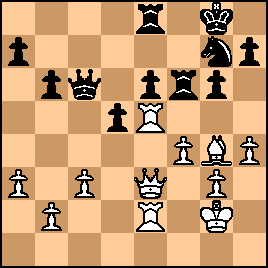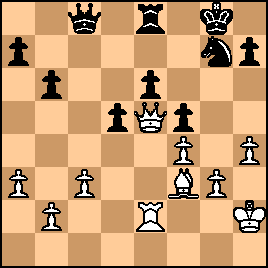KEG: Post III
29. h4!
Finally playing h4 and not going in for 29. Qxa7 h5 30. Bd1 Ref8 (much better than the Tournament Book's suggested 30...b6) which, while leaving White with some edge (being up a pawn) would give Black fine (and almost equalizing) counterplay. 30. Kg2
An excellent multi-purpose move.
30... Qc6

click for larger viewThe move-30 time control had been reached, and Tarrasch--though hardly enjoying a decisive advantage--since had a vise on von Popiel's position. It is strange that it was at this point that Tarrasch faltered: 31. f4?
"?"--(Tournament Book)
"Not good as now Black could now isolate a pawn on c3 by 31...d4+" (Tournament Book) Much better for White were 31. f3 or 31. Qd4.
But von Popiel missed his chance:
31... Qa4+
The Tournament Book's 31...d4+ would have eliminated most of Tarrasch's pressure (31...d4+ 32. Q4 QxQ+ 33. R5xQ dxc3 34. bxc3 after which White's isolated pawn on c3 is about a big a problem as would be Black's isolani one e6. Now, Tarrasch was back in business.
32. a3 Qb5
33. Re2 Qc6

click for larger view34. Kh2!
Essential if White is to retain his bind on the Black position. 34... Qd6
35. Rd2
Giving Black no respite.
35... Qc6
36. Bf3 Qc8
37. Re2
"!"--(Tournament Book)
"Threatening Bxd5." (Tournament Book)
37... Rf5

click for larger view38. RxR?
In my introductory remarks on this game, I forgot that this--like Tarrasch;s 31st move--was a mistake that almost forfeited his edge. 38. h5 was the logical continuation of his earlier play. The text gave von Popiel a chance for near equality: 38... gxR?
Missing 38...NxR which would simplify his defense. 39. Qe5
"Black has no satisfactory defense." (Tournament Book) A gross overstatement.

click for larger viewThe Tournament Book notwithstanding, Black had good chances to hold--despite Tarrasch's continuing pressure--with 39...Qb8 or 39...Qd8. But here von Popiel fell apart: 39... h5?
Giving Tarrasch the sort of chance from which there was little chance of escape. The Tournament Book is correct that 39...Kf7 would have been a serious mistake in light of 40. g4. But the text was even worse. 40. Qf6!
Of course!

click for larger viewNow indeed the Black position may be beyond salvation. Whether that was the case we will never know, since from here von Popiel played two bad moves followed by three blunders after which Tarrasch--who probably did not need such help--ran von Popiel off the board. | 




